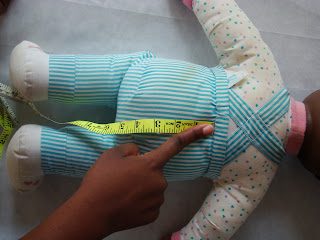Every baby is different; and although size charts are helpful, it is best to physically measure your child to find what size range they fall into.
The basic factors that effect the fit of diapers are the rise, waist, thigh and "bottom width".
The rise refers to the length from belly button to lower back. To take this measurement, position the measuring tape at the back of the waist right in line with the navel, through the legs stopping just under the belly button, making sure there is slack in the crotch area. You may find it helpful to perform this over a diaper.
The second is the waist. Simply position the measuring tape at the navel and wrap around ending where you began. Be sure the tape is snug not tight around the your baby's waist.
Next, measure the thigh finding the largest part closest to the hip joint.
Last but not least, I like to call this measurement" bottom width". Most people do not think about this, but, I found my little one's bottom was at least one inch wider than manufactured cloth diapers, so I created a custom pattern. To find this, locate the widest part of your baby's bottom drawing the tape from one side to the other, resting in the crease between the bottom and upper thigh.
Once these measurements are tallied, you can then efficiently find the proper size for your baby. When looking at common size charts it is better to have your measurements fall at the lower end of the category. That way you will gain greater use from your size specific cloth diapers.
Are you steadfast on one size diapers? Sadie's Babies currently offers one size diapers to fit 8-35 lbs. Click here to find out more.
Did you find this helpful? Let me know...











